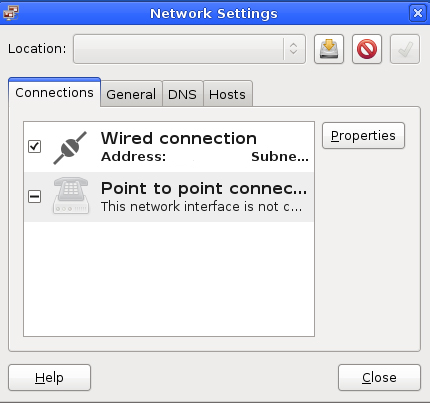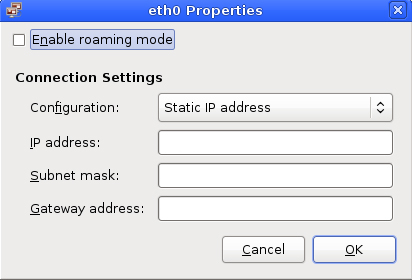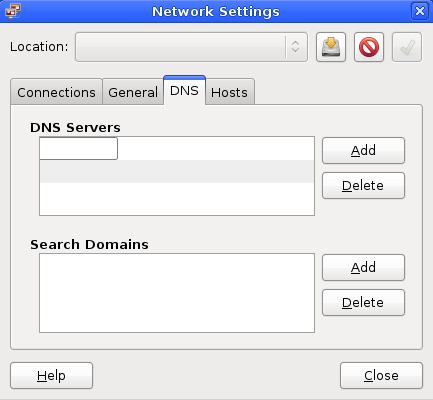Network Settings
Contents
Setting a static IP (xterm)
Groovix network settings can be configured using xterm by typing the command nano /etc/network/interfaces and editing the following text:
auto lo
iface lo inet loopback
iface eth0 inet static
address x.x.x.x
netmask x.x.x.x
gateway x.x.x.x
auto eth0
Use the proper IP addresses in place of each x.
Log out and back in again before trying a test search on google.com in Firefox; if a timeout occurs, double check the settings and try again. On some hardware (especially wireless) it may be necessary to reboot after changing network parameters. Once the workstation can browse web pages in Firefox, choose "Reboot the machine" from the Groovix Menu so your machine can be configured by the Groovix NetCustomization System.
Setting Wireless Network Parameters
To set wireless parameters, open a terminal window and edit the interfaces file by typing nano /etc/network/interfaces.
Add a section after the interface you want to use wirelessly and add the line wireless-essid [SSID] where [SSID] is the name of your wireless network. Next, include the line wireless-key1 [PASSWORD] where [PASSWORD] is the password you use for your wireless network; if your wireless network does not have a password, do not include the wireless-key1 line.
Below is an example of a /etc/network/interfaces file with the wireless settings added to interface wlan0.
auto lo
iface lo inet loopback
auto eth0
iface eth0 inet dhcp
auto wlan0
iface wlan0 inet dhcp
wireless-essid [SSID]
wireless-key1 [PASSWORD]
Setting Wireless Network Parameters using WPA2
To set wireless parameters, open a terminal window and edit the interfaces file by typing nano /etc/network/interfaces.
Add a section after the interface you want to use wirelessly and add the line wpa-ssid [SSID] where [SSID] is the name of your wireless network. Next, include the line wpa-psk [HEX KEY] where [HEX KEY] is the password you use for your wireless network.
Below is an example of a /etc/network/interfaces file with the wireless settings added to interface wlan0.
auto lo
iface lo inet loopback
auto eth0
iface eth0 inet dhcp
auto wlan0
iface wlan0 inet dhcp
wpa-driver wext
wpa-ssid [SSID]
wpa-ap-scan 2
wpa-proto RSN
wpa-pairwise CCMP
wpa-group CCMP
wpa-key-mgmt WPA-PSK
wpa-psk [HEX KEY]
Troubleshooting
Running the following commands in a terminal window Terminal Guide can assist you in troubleshooting network issues by restarting your network devices or giving you information about the current values applied to your network interfaces.
/etc/init.d/networking restart - this restarts the networking and is usually sufficient to make changes take effect but sometimes a reboot is required.
ifconfig - shows all networking information, you are usually just interested in eth0 (usually wired) and wifi0 or ath0 or eth1 or ? (usually wireless) , lo is the loopback device, you can ignore it
iwconfig - shows wireless specific information including signal strength (usually called Link Quality, sometimes out of 5, sometimes out of 70, etc.)
ping [IP Address/web address] - sends out test signals to a network address and reports back if they were received or dropped. Useful in troubleshooting communications between devices.
Setting a static IP (Old Method using GUI, no longer works as of version 9.10)
While logged in, hit CTRL+ALT+G to bring up the Groovix Menu. After a few seconds enter the root password in the pop up box. Once in the Groovix Menu, choose "Network Settings". In the network settings dialog box, highlight "Wired connection" and click properties [FIG.1].
On the Connections tab, choose eth0, click properties to configure the network interface [FIG.2]:
- Uncheck "Enable roaming mode"
- Set "Configuration" to "Static IP Address"
- Set "IP address", "Subnet Mask", and "Gateway Address" appropriately for your network.
- Click "OK"
On the DNS tab [FIG.3]:
- Add your DNS servers
- Click "Close".
Log out and back in again before trying a test search on google.com in Firefox; if a timeout occurs, double check the settings and try again. On some hardware (especially wireless) it may be necessary to reboot after changing network parameters. Once the workstation can browse web pages in Firefox, choose "Reboot the machine" from the Groovix Menu so your machine can be configured by the Groovix NetCustomization System.


